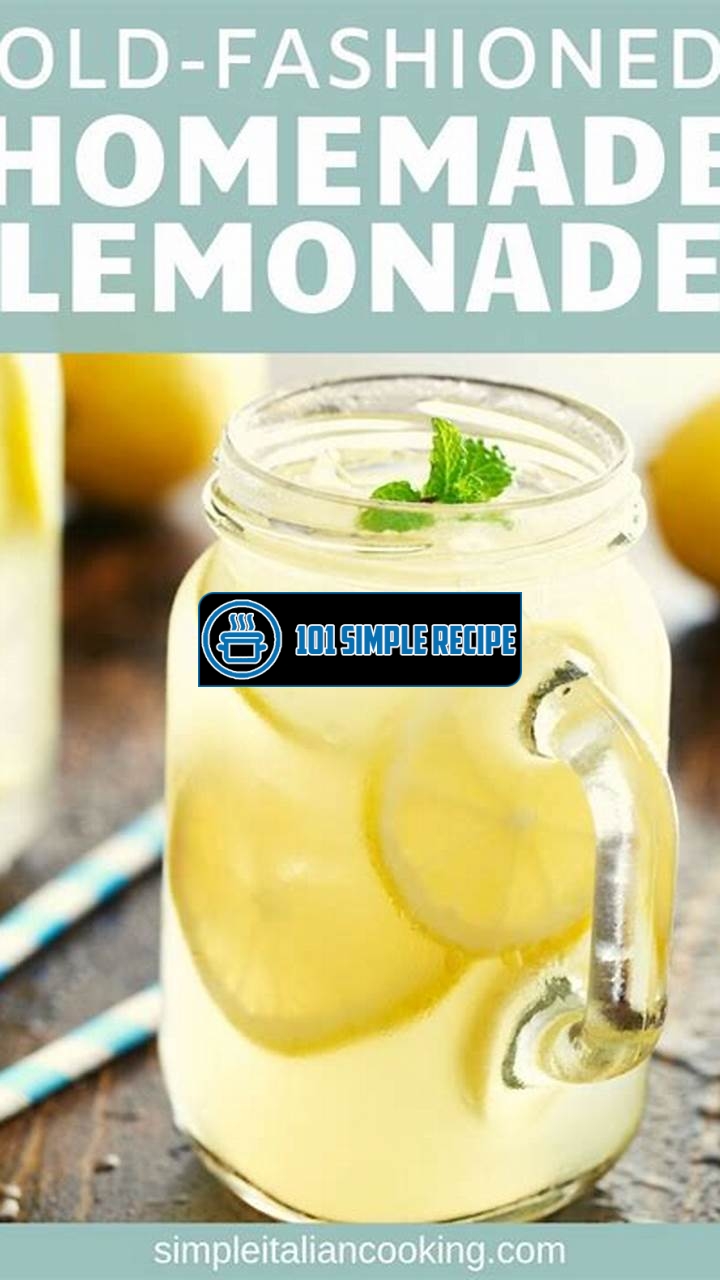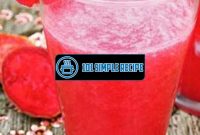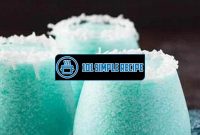If you’re in need of a refreshing drink to beat the summer heat, look no further! Making lemonade by the gallon has never been easier. Whether you’re hosting a backyard BBQ, a family gathering, or simply want to enjoy a tall glass of citrusy goodness whenever you please, this recipe will have you covered. With just a few simple ingredients and a little bit of time, you can whip up a delicious batch of homemade lemonade that will quench your thirst like nothing else. So, grab your pitcher, roll up your sleeves, and let’s get started on your lemonade-making adventure! ✨

Choosing the Perfect Lemons
Discover the importance of selecting the right kind of lemons for the perfect gallon of lemonade.
Identifying the Best Lemon Varieties
When it comes to making delicious and refreshing lemonade by the gallon, choosing the right kind of lemons is crucial. Not all lemon varieties are created equal, and certain types are better suited for lemonade than others.
One of the best lemon varieties for making lemonade is the Meyer lemon. Known for its sweeter flavor and thinner skin, Meyer lemons add a unique and delightful taste to your lemonade. They are also generally juicier, making it easier to extract the maximum amount of juice for your gallon.
Another popular lemon variety for lemonade is the Eureka lemon. This variety has a tangier and more acidic flavor compared to Meyer lemons. If you prefer a tart and zesty lemonade, Eureka lemons are an excellent choice.
Lastly, Lisbon lemons can also be used for lemonade. They have a bright yellow color and a strong citrus aroma. While they are not as sweet as Meyer lemons, they still offer a refreshing and tangy flavor.
Choosing Ripe and Flavorful Lemons
Now that you know which lemon varieties work best for lemonade, it’s important to select ripe and flavorful ones. Ripe lemons will be plump and heavy for their size, indicating a higher juice content.
Look for lemons that have a bright and vibrant yellow color. Avoid any lemons that have greenish tones or soft spots, as these indicate they are underripe or starting to spoil.
The skin of the lemon should feel smooth and slightly firm to the touch. Avoid lemons with wrinkled or overly soft skin, as they may be older and less juicy.
Give the lemon a gentle squeeze. Ripe lemons will have a slight give without being too soft. If the lemon feels hard and unyielding, it may not be fully ripe and won’t provide as much juice.
Tips for Storing Lemons
Once you’ve chosen your lemons for your gallon of lemonade, it’s important to store them properly to keep them fresh and flavorful.
Store lemons at room temperature if you plan to use them within a week. Keep them in a bowl or container away from direct sunlight.
If you need to store lemons for a longer period, place them in the refrigerator. However, note that refrigeration may cause the lemons to become drier over time.
To extend the shelf life of cut lemons, store them in an airtight container or wrap them tightly in plastic wrap. This will help prevent them from drying out and losing their juiciness.
By choosing the best lemon varieties, selecting ripe and flavorful lemons, and storing them properly, you can easily make refreshing lemonade by the gallon. So go ahead and enjoy the sweet and tangy flavors of homemade lemonade on a hot summer day!
If you’re a fan of cookies, you’ll love this cookie in a mug recipe. It’s a quick and easy way to satisfy your sweet tooth.
The Art of Juicing Lemons
When it comes to making refreshing lemonade by the gallon, mastering the art of juicing lemons is essential. Extracting the maximum amount of juice from lemons will ensure that your lemonade is bursting with flavor and tanginess. Here are some techniques to help you become a lemon-juicing pro:
Manual Juicing vs. Using a Juicer
There are two main methods for juicing lemons – manual juicing or using a juicer. Each method has its pros and cons, so let’s take a closer look:
- Manual Juicing: This traditional method requires a bit of elbow grease but can be quite effective. To manually juice lemons, start by rolling them firmly on a countertop or applying slight pressure with your palm. This helps to break down the lemon’s fibers and release the juice. Cut the lemon in half and use a citrus reamer or a fork to extract the juice. Manual juicing is a great option if you don’t have a juicer and don’t mind putting in a little extra effort.
- Using a Juicer: If you have a juicer at home, this method can save you time and effort. Simply cut the lemons in half and feed them into the juicer. The juicer will do the hard work for you, extracting the juice with ease. This option is perfect if you’re juicing a large quantity of lemons or prefer a more efficient process.
Essential Equipment for Juicing
Regardless of the juicing method you choose, having the right equipment is essential. Here are some items you’ll need:
- Citrus Reamer or Fork: These tools are perfect for manually juicing lemons. The citrus reamer has a cone-shaped tip that efficiently extracts the juice. A fork can also be used if you don’t have a citrus reamer.
- Juicer: If you opt for using a juicer, make sure to invest in a good-quality juicer. Look for one with a powerful motor and easy-to-clean components for convenience.
- Bowl or Pitcher: You’ll need a container to collect the freshly squeezed lemon juice. Choose a bowl or pitcher that can hold the desired amount of juice needed for your lemonade recipe.
The Juicing Process Step-by-Step
Now that you have the necessary techniques and equipment, let’s go through the juicing process step-by-step:
- Roll the lemons: Place the lemons on a countertop and firmly roll them with your palm. This helps to soften the fruit and make it easier to juice.
- Cut the lemons: Using a sharp knife, cut the lemons in half lengthwise.
- Juice manually or use a juicer: Depending on your preference, either manually juice the lemons using a citrus reamer or fork, or use a juicer according to its instructions.
- Collect the juice: Direct the extracted juice into a bowl or pitcher, ensuring you capture the maximum amount of liquid.
- Strain (optional): If desired, strain the juice to remove any pulp or seeds for a smoother lemonade.
- Store or use immediately: Transfer the fresh lemon juice to a storage container or use it right away in your lemonade recipe.
By following these techniques and steps, you can easily extract the maximum amount of juice from lemons for your refreshing lemonade. Time to quench your thirst with a tall glass of homemade goodness!
Looking for more drink recipes? Check out this punch bowl recipe that’s perfect for parties and gatherings.
Creating the Perfect Lemonade Base
Are you ready to quench your thirst with a refreshing batch of homemade lemonade? Look no further! In this article, we will guide you through the process of creating a lip-smacking lemonade base that will serve as the foundation for your gallon-sized refreshment. Get ready to tantalize your taste buds with every sip.
Choosing the Sweetener: Sugar or Honey?
When it comes to sweetening your lemonade, there are two popular options: sugar or honey. Each has its own unique flavor profile, so you can choose the one that best suits your taste preferences.
Sugar: The most traditional choice for sweetening lemonade is granulated sugar. Its sweet and neutral taste allows the tanginess of the lemons to shine through. To use sugar as your sweetener, simply dissolve it in hot water to create a simple syrup. This will ensure that the sugar is evenly distributed throughout the lemonade base, preventing any gritty texture when you take a sip.
Honey: For a more distinctive flavor, you can opt for honey as your sweetener. Honey adds a touch of complexity to your lemonade, with its floral and slightly earthy notes. When using honey, it is important to remember that its taste can vary depending on the type and quality. To incorporate honey into your lemonade base, warm it slightly to make it easier to mix with the other ingredients.
Note: If you are looking for a healthier alternative to refined sugar, honey is a great option. Not only does it provide sweetness, but it also offers some additional health benefits.
Enhancing the Flavor with Citrus Zest
Now that you have chosen your sweetener, it’s time to add some zest to your lemonade base. Citrus zest is the colorful outermost layer of the fruit’s peel and is packed with aromatic oils that can elevate the flavor of your drink.
You can use the zest of various citrus fruits like lemons, limes, oranges, or even grapefruits. To extract the zest, simply use a microplane or a fine grater to scrape off the colored portion of the peel. Make sure to avoid the bitter white pith.
Note: Zesting citrus fruits not only enhances the taste but also adds a lovely aroma to your lemonade. It’s a simple step that can make a big difference.
Balancing the Tartness and Sweetness
The key to a perfectly balanced lemonade base is finding the right harmony between the tartness of the lemons and the sweetness of your chosen sweetener. This is where your personal taste comes into play.
Start by adding a smaller amount of your sweetener to the lemonade base and gradually increase it until you reach your desired level of sweetness. Keep tasting and adjusting until you find the perfect balance. Remember, you can always add more sweetness if needed, but it’s harder to dial it back once it’s too sweet.
Note: If you prefer a more tangy lemonade, you can decrease the amount of sweetener or add a splash of fresh lemon juice. On the other hand, if you have a sweet tooth, feel free to experiment with different sweeteners or add a little more than the recommended amount.
Now that you have mastered the art of creating a perfect lemonade base, it’s time to get creative with your garnishes and serve it over ice for a truly refreshing experience. Cheers to your homemade masterpiece!
If you’re looking for a refreshing drink, try this easy lemonade recipe. It’s quick to make and perfect for a hot summer day.
Bulk Lemonade Measurements and Adjustments
When it comes to making refreshing lemonade by the gallon, it’s important to understand the science behind scaling up a basic recipe for larger quantities. You want to make sure that the taste doesn’t get diluted and that the flavors are well-balanced. In this section, we will explore the process of converting a lemonade recipe into gallons and how to make adjustments to suit your taste preferences.
Recipe Conversion for Gallons
Converting a lemonade recipe for gallons requires some simple math and understanding of ratios. To start, you’ll need to determine how many servings you want to make. Let’s say you want to make enough lemonade for 20 servings, and each serving is 8 ounces. Since there are 128 ounces in a gallon, you’ll need to prepare:
- 20 servings x 8 ounces = 160 ounces
- 160 ounces ÷ 128 ounces/gallon = 1.25 gallons
So, in this example, you would need to make 1.25 gallons of lemonade to accommodate 20 servings. It’s important to note that the formula for scaling up a recipe may vary depending on the specific recipe you are working with, so always check the instructions provided.
Taste Testing and Adjusting Flavor
Once you’ve converted the recipe and made your lemonade by the gallon, it’s time to taste test and adjust the flavor to your liking. Some people prefer their lemonade to be sweeter, while others enjoy a more tart flavor. Here are a few tips to help you achieve the perfect balance:
- Start by sampling a small amount of the lemonade and take note of any specific flavors that stand out.
- If the lemonade is too tart, you can add a bit more sugar or a sweetener of your choice. Gradually add small amounts and taste as you go, making sure not to overpower the natural citrus flavor.
- If the lemonade is too sweet, you can dilute it with a splash of water. This will help mellow out the sweetness without compromising the overall flavor.
- Consider adding a pinch of salt to enhance the flavors. Salt can subtly balance out both sweetness and tartness, resulting in a more well-rounded taste.
- Remember, taste testing and adjusting is a subjective process, so trust your instincts and experiment until you achieve the desired flavor.
Note: It’s always a good idea to keep track of the adjustments you make, especially if you plan on making the same recipe again in the future. This way, you can easily replicate your preferred flavor profile.
Making Lemonade Variations
Once you have perfected the art of making refreshing lemonade by the gallon, it’s time to get creative and explore different variations. Here are some ideas to inspire you:
| Variation | Ingredients | Instructions |
|---|---|---|
| Strawberry Lemonade | Fresh strawberries, lemon juice, sugar, water | Muddle strawberries, combine with lemon juice, sugar, and water. Stir until sugar dissolves. |
| Mint Lemonade | Lemon juice, sugar, water, fresh mint leaves | Muddle mint leaves, combine with lemon juice, sugar, and water. Stir until sugar dissolves. |
| Sparkling Lemonade | Lemon juice, sugar, water, sparkling water | Combine lemon juice, sugar, and water. Add sparkling water for a fizzy twist. |
Feel free to experiment with different fruits, herbs, and even sparkling water to create unique and refreshing lemonade variations.
In conclusion, by understanding the science behind scaling up a basic lemonade recipe and making adjustments to suit your taste preferences, you can easily make refreshing lemonade by the gallon. Remember to convert the recipe accurately, taste test and adjust to achieve the perfect balance, and explore different variations to keep things exciting. Enjoy your homemade lemonade and cheers to quenching your thirst during those hot summer days!
Serving and Presentation Tips
Elevate your lemonade experience with creative serving ideas and beautiful presentation techniques. By paying attention to detail in how you serve and present your refreshing lemonade, you can enhance the overall enjoyment for yourself and your guests.
Garnishing and Zesting for Visual Appeal
Add visual appeal to your gallon of lemonade by incorporating garnishes and zesting. Not only do these additions enhance the aesthetic appeal of your drink, but they can also add extra flavor and aromas.
- Garnishes: Consider using fresh sprigs of mint, slices of lemon or lime, or even edible flowers as garnishes for your lemonade. These visually pleasing elements will instantly make your drink look more refreshing and appetizing.
- Zesting: Another way to add a pop of flavor and visual interest is by grating lemon zest directly into your lemonade. This will release the oils and provide a burst of citrus essence with every sip. ✨
The Perfect Glassware for Lemonade
Choosing the right glassware for serving your lemonade can make a significant difference in the overall presentation. Consider these options to elevate your lemonade experience:
- Tall, Clear Glasses: Opt for tall, clear glasses to showcase the vibrant color of your lemonade. The transparency of the glass will allow the drink to be the center of attention.
- Mason Jars: For a rustic and charming presentation, serve your lemonade in mason jars. These iconic jars add character and a touch of nostalgia to your drink.
- Colorful Stemware: If you want to add a touch of elegance to your lemonade, consider using colorful stemware. The vibrant hues of the glasses will complement the bright color of the lemonade.
Refreshing Lemonade Pairings
Take your lemonade experience to the next level by pairing it with complementary flavors and snacks. These combinations will enhance the overall taste and provide a satisfying refreshment.
- Watermelon Lemonade: Combine the refreshing flavors of watermelon and lemonade for a fruity and hydrating beverage. Serve it with watermelon skewers for an extra treat.
- Minty Lemonade: Add a twist to your lemonade by infusing it with fresh mint leaves. The minty flavor complements the citrusy taste perfectly. Pair it with cucumber slices for a crisp and cool experience.
- Sparkling Lemonade: Turn your regular lemonade into a fizzy delight by adding sparkling water or soda. Top it off with a slice of lemon or lime for a sparkling presentation. ✨
By incorporating these serving and presentation tips, you can create an unforgettable lemonade experience. The visual appeal, combined with delicious flavor pairings, will leave your guests impressed and refreshed. Cheers to a perfect glass of lemonade!
Thank you for taking the time to read our article on how to make an easy lemonade recipe gallon. We hope you found the instructions clear and easy to follow. Now you can enjoy a refreshing glass of homemade lemonade whenever you want. If you have any questions or feedback, please feel free to leave a comment below. Don’t forget to bookmark our page and visit again for more delicious recipes and helpful tips. Cheers to a summer filled with icy cold lemonade!
Frequently Asked Questions
Here are some frequently asked questions about this easy lemonade recipe:
| No. | Questions | Answers |
|---|---|---|
| 1. | Can I use bottled lemon juice instead of fresh lemons? | Yes, you can use bottled lemon juice, but fresh lemons will give you the best flavor. |
| 2. | Can I add other fruits to the lemonade? | Absolutely! You can experiment with adding fruits like strawberries, raspberries, or even watermelon to create different flavors. |
| 3. | How long does the lemonade last in the refrigerator? | The lemonade can be stored in the refrigerator for up to 1 week. Just make sure to give it a good shake before serving. |
| 4. | Can I use honey instead of sugar to sweeten the lemonade? | Yes, you can substitute honey for sugar. Start with a lesser amount and adjust to your desired sweetness. |
| 5. | Can I make a smaller or larger batch of lemonade? | Absolutely! Just adjust the quantities of the ingredients accordingly to make a smaller or larger batch. |
| 6. | What can I do with leftover lemonade? | You can use the leftover lemonade to make popsicles, add it to cocktails, or freeze it into ice cubes for future use. |
Easy Lemonade Recipe Gallon
Try our easy lemonade recipe to quench your thirst on a hot summer day. This tangy and refreshing drink is made with freshly squeezed lemons, sugar, and water. It takes just a few minutes to prepare, and the result is a gallon of delicious homemade lemonade that the whole family can enjoy. So grab your lemons and get ready to make the best lemonade you’ve ever tasted!
Jump to Recipe
Easy Lemonade Recipe Gallon

Learn how to make an easy lemonade recipe gallon and enjoy a refreshing glass of homemade lemonade. Perfect for hot summer days!
- 12 lemons (juiced)
- 1 ½ cups sugar
- 8 cups water
- Cut the lemons in half and squeeze out the juice. Make sure to remove any seeds.
- In a pitcher, combine the lemon juice and sugar. Stir until the sugar is completely dissolved.
- Add the water to the pitcher and stir well to combine. Taste and adjust the sweetness or tartness by adding more sugar or lemon juice if desired.
- Refrigerate the lemonade for at least 1 hour to chill. Serve over ice and garnish with lemon slices. Enjoy!






